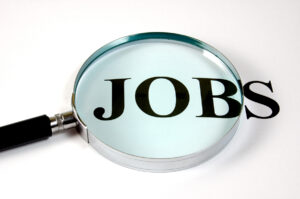It comes when you least expect it. It comes when you can least afford it. It comes when you thought your “safe” job was forever. Usually the event takes place at about 3 PM on an ordinary work day when your boss calls you in for a “friendly” chat. It can happen anywhere: in an office setting, on a construction site, or in a retail store. Where and when it happens does not matter. The results are the same for every worker; a president, a retail clerk, an editor, a truck driver, a sales representative, or an IT director.
This event is being fired or laid off by your employer and it has many different names; fired, laid off, downsized, reorged out, rightsized, riffed, whacked, kicked out, canned or just plain “let go.” How often does it happen? Each day 50,000 American workers lose their jobs. That’s over 20 million workers per year!
LOSING YOUR PERSONAL IDENTITY
The ramifications of job loss are staggering, particularly for mid-career workers who have serious family and financial obligations like a home mortgage, car payments, insurance, child care, and high school or college tuition. When your boss says, “this is your last day on the job” your world seems to be coming apart at the seams. You are no longer Mary Jones, Marketing Director for General Electric, or Joe Smith, Sales Manager for Metlife Insurance; now you are just plain Mary and Joe. No job title or company name to define who you are. No salary and benefits to render you a self-sufficient human being. No money for food, shelter, clothing and other modern day necessities. Next to divorce or death of a loved one, being fired or laid off is the most traumatic event a worker can experience.
This event has no favorites. When you are fired or laid off you might think, “Wait a minute. It can’t happen to me. I’m sixty years old and letting me go would be age discrimination.”
OR
“I’m African American. Downsize me and that’s racial discrimination.”
OR
“I’m a woman. Fire me and that’s gender discrimination.”
Dream on. There is no mercy when your employer decides to shrink the payroll. You are going, no matter what you are or who you are. You are finished. Done. Kaput. Wiped out. Welcome to the real world!
THE GRIEVING PROCESS
When you are escorted from the job site to your car or public transportation, the grieving process sets in and it is not pretty. It usually begins with humiliation, followed by anger, resentment, depression and finally acceptance.
Humiliation
Humiliation affects workers in many different ways. To some it means losing face, degradation, confusion, and shame. To others it means indignity, disgrace and dishonor. Whatever it means personally, your ego is crushed like nothing else. “How could this be happening to me? I’ve played by the rules, met job objectives and my reward is being let go.” You just can’t believe you are the target of a blood-letting at your employer.
And what about the talk from former coworkers? “What are they thinking and saying about me? Do they believe that I did something seriously wrong? And how about my family? Walking in the door and saying I’ve been fired will be extremely painful.” This loss of dignity, this utter humiliation, sets you up for the next stages in the grieving process, anger and resentment.
Anger and Resentment
Anger and resentment are usually directed at the boss and/or the human resources director, but it could reach as far as the president or CEO. “How could ‘they’ do such a thing to me, an honest and dedicated worker?” To shortcut the anger stage, remember that your being let go was in all probability not personal. It was most likely the result of a general company initiative to save money. Employers do not lay off workers without serious forethought because hiring another worker is very costly. When you trace the chain of events that led to your being let go, it most frequently comes back to the numbers. Most workers move past the anger stage by hurling some juicy epithets at their former employer, ones that you would not want to see in print. If you are still in this stage, try it. Tell your former boss and the HR director in no uncertain terms how you feel. Get it off your chest, in private, and then move on.
Depression
Most workers enter a state of self-pity after suffering a serious misfortune that has multiple ramifications, like losing a job along with a paycheck and benefits. You can short circuit this phase of the grieving process by remaining positive about the future. In America, a country that employs 155,000 million workers, there is always something out there for those who know how to hunt for a job.
The best solution to head off depression is to remain active. Devise a job hunting plan as soon as possible making your number one priority personal networking by attending conferences and job fairs where you will meet potential hiring managers. Sitting at home and texting your friends and acquaintances a tale of woe could lead to depression and sessions with a psychologist or psychiatrist. If you find yourself in such a state, do seek professional counseling.
Acceptance
After being out of work for a month or more, you will meet others who suffered the same fate. This did not happen only to you. Statistics from the U.S. Department of Labor, www.bls.gov, reveal that: each day 50,000 workers are laid off or fired in the United States; and, that today’s workers will change jobs six times during their working years.
This is not the end of the world. In America, jobs are always available for workers who know what they want and know how to implement a job hunting plan.
There are some positives after suffering job loss. First, you will have time to examine your career goals, and second, you will have time to examine and possibly rebuild your persona and character. This is important because a character flaw could have been responsible for your being let go.
REDEFINING YOUR PERSONA AND IMPROVING YOUR CHARACTER
Being fired or laid off is traumatic, but it does have two specific benefits.
- It opens the door to examining and possibly reshaping your persona.
- It provides an opportunity to rebuild your character.
Redefining Your Persona
The word persona derives from the Latin where it originally meant a theatrical mask. In theatrical terms, it translates into an assumed personality. In today’s world it refers to that part of your personality exposed to the public. It is the apparent you that people see and it may be different from your character, the real you. It is you who created your persona, either consciously or subconsciously.
People in the public eye such as TV personalities, actors, and politicians frequently assume a certain persona that appeals to their target audience. Take politicians, for example. They want to be viewed by constituents as caring for their welfare and the needs of the country as a whole, but in reality, some politicians use public office for personal gain.
Persona in the private sector is similar. Look at your own persona in the workplace. If you were in a leadership position, i.e. the boss, what was your persona? Was it in conflict with the real you? Did you portray yourself as the good, compassionate, helpful, caring boss dedicated to making the company great? However, did you assume this persona, this mask, to hide your real motivation; to oust your boss and move up in rank and compensation? Could it have been the reason why you were let go from your job as Regional Sales Manager in a staged “reorganization” while your friend Mary, another Regional Sales Manager was kept on the payroll? Only you can answer that after a private, honest meeting with yourself.
Before implementing your job hunting plan discover who you really are. Were you the one who used every chance to derail your boss while playing Mister Good Guy? If your introspection reveals a difference between your persona and the real you, take measures to make these two competing entities one and the same. How do you begin? With honesty. If you have any doubts about how you are seen, ask your former boss and coworkers what they thought of you, no holds barred.
Rebuilding Your Character
For our purposes, we define character as the aggregate of traits and features that form and identify the real you. Your character is the set of values and ethics that you hold dear. They determine not only what you say, but also how you act.
This period of downtime provides an excellent opportunity to learn who you really are. Looking back, you might find that the real you became lost in the corporate culture, maybe disguised by a preoccupation with political correctness. In the course of your previous job, you may have forgotten what you truly believe or how you feel. It’s time for a homecoming with yourself to find out who you really are.
To begin the process of rebuilding character, you need a foundation upon which everything else rests. We like the foundation stones posited by Character Counts!, a nonprofit organization dedicated to character education. One of their constructs is the Six Pillars of Character, which act as the foundation for building character. They are: trustworthiness, fairness, respect, caring, citizenship, and responsibility. You can review this material at: www.charactercounts.org.
MOVING FORWARD
The rebuilding process may be filled with fear, doubts, maybes, should haves, would haves, and could haves. However, it is not these burdens that will drive you to distraction. Rather, it’s the regrets over yesterday and the fear of tomorrow. Learn from the past but do not accept the past as prologue. Get rid of the two demons, regret and fear, that will inhibit your growth. Move forward with confidence. Using your intelligence, energy, passion, and your revised persona and character, you will succeed. The world is yours for the taking!
TAKEAWAYS
- Persona is the face you present to the public at large.
- Character is who you really are.
- Persona and character must work in harmony for growth in your career.
- Regrets about the past and fear of the future are two demons that will inhibit your growth. Let go the regrets. Face the future with confidence and hope.
- Integrity and trust form the foundation for your character.
- Having good character means being who you are even when nobody is watching.
For additional information about rebuilding your character after being fired of laid off, please refer to my book, Moving Forward in Mid-Career: A Guide to Rebuilding Your Career after Being Fired or Laid Off. It will be available in paperback or eBook In December 2017 from Amazon, Barnes & Noble and Skyhorse Publishing Inc.
Helpful Career Planning Tools
Visit our other informative site
- http://FederalJobs.net (Explore occupations and find jobs)
- http://fedcareerinfo.com (A career management workbook for federal employees)
- http://federalretirement.net (Retirement & other federal employee benefits)
The information provided may not cover all aspects of unique or special circumstances, federal and postal regulations, and programs are subject to change. Our articles and replies are time sensitive. Over time, various dynamic human resource guidance and factors relied upon as a basis for this article may change. The advice and strategies contained herein may not be suitable for your situation and this service is not affiliated with OPM, the postal service or any federal entity. You should consult with school counselors, hiring agency personnel offices, and human resource professionals where appropriate. Neither the publisher or author shall be liable for any loss or any other commercial damages, including but not limited to special, incidental, consequential, or other damages.






